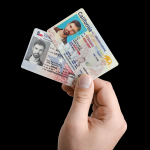Why Real ID Appeals Matter: A Quick Overview
A Real ID serves as a federally compliant form of identification, required for accessing secure federal facilities, boarding domestic flights, and other official purposes post-2025. If your application was denied, it’s not the final word—most states allow an appeal process to correct errors or provide additional documentation. This guide breaks down actionable steps to navigate a denial, ensuring you understand each phase of the appeal journey.
Step 1: Decode Your Denial Letter
The first critical move after a denial is to carefully review the official letter from your state’s Department of Motor Vehicles (DMV). This document outlines *exactly* why your application failed. Common denial reasons include:
- Missing or incomplete documentation (e.g., no proof of Social Security number)
- Submitted documents deemed invalid (e.g., a photocopied birth certificate instead of a certified original)
- Discrepancies in personal information (e.g., name on ID doesn’t match Social Security records)
- Issues with residency verification (e.g., utility bills not showing your current address)
Highlight key phrases like “insufficient proof of identity” or “name mismatch” to focus your appeal. If the letter is vague, contact your local DMV immediately for clarification—ambiguity can stall progress.
Step 2: Research State-Specific Appeal Rules
Real ID regulations vary by state, so appeal processes aren’t uniform. For example:
– California requires submitting a written appeal within 60 days of denial.
– Texas may ask for an in-person review at a local office.
– Florida allows online appeals through its MyDMV portal.
Visit your state’s DMV website (search “[Your State] DMV Real ID appeal”) to find:
– Deadlines for filing (missing these often voids your appeal)
– Required forms (e.g., “Appeal of Denial for Real ID Application”)
– Acceptable documentation lists (updated annually)
– Contact details for the appeals department (phone, email, or physical address)
Step 3: Gather and Organize Corrective Documentation
Once you know the denial reason, gather the *exact* documents needed to address it. Examples include:
Scenario 1: Missing Proof of Social Security Number
If denied for lacking a Social Security card, provide:
– Original Social Security card (not a copy)
– W-2 form showing your full Social Security number
– SSA-1099 (Social Security benefit statement)
Scenario 2: Invalid Identity Document
If a driver’s license was rejected (e.g., it’s expired), substitute with:
– Certified U.S. birth certificate (issued by a state/county, not a hospital)
– Valid U.S. passport
– Certificate of Naturalization (Form N-550)
Scenario 3: Name Mismatch
If your ID shows a different name than your Social Security records, include:
– Marriage certificate (with raised seal)
– Court-ordered name change document
– Divorce decree (if reverting to a prior name)
Pro Tip: Always submit original documents—copies are rarely accepted. If originals are unavailable (e.g., a lost birth certificate), request certified replacements from the issuing agency (e.g., state vital records office).
Step 4: File the Appeal
With your paperwork ready, follow these submission steps:
- Complete the appeal form: Download or request the official appeal form from your state’s DMV. Fill it out neatly, ensuring all fields (especially your application number) are accurate.
- Attach supporting documents: Include copies of the denial letter, corrected/additional documents, and a brief cover letter explaining the denial reason and how you’ve addressed it. Example: “My initial application lacked a certified birth certificate; enclosed is the original from [County] Vital Records.”
- Submit via preferred method: Most states accept appeals by mail, in-person, or online. If mailing, use certified mail with return receipt to track delivery. For online submissions, save confirmation emails.
Step 5: Follow Up on Your Appeal
After submission, monitor your appeal’s status:
– Check timelines: States typically respond within 30–60 days. If no update arrives, call the appeals department.
– Keep records: Save copies of all submitted documents, the appeal form, and delivery receipts. These protect you if the DMV claims missing paperwork.
– Prepare for next steps: If the appeal is approved, you’ll receive instructions to pick up your Real ID. If denied again, explore a formal hearing (some states require this as the final appeal stage).
Common Problems and Solutions
Even with careful preparation, roadblocks may arise. Here are five frequent issues and how to resolve them:
Problem 1: “I Submitted All Documents, but the Appeal Was Denied”
What Happened: The DMV may have overlooked or misinterpreted your paperwork. For example, a utility bill with a PO box might not count as residency proof in some states.
Solution: Request a copy of the appeal decision letter to identify the new denial reason. If it’s a misunderstanding, gather additional context (e.g., a letter from your landlord confirming physical address) and resubmit with a clarified cover letter.
Problem 2: “My Birth Certificate Was Rejected as ‘Uncertified’”
What Happened: Many applicants submit “informational” birth certificates (printouts from online services) instead of “certified” ones (with a state seal or raised stamp).
Solution: Order a certified copy from the vital records office in your birth state. This typically costs $10–$30 and takes 5–10 business days. Include a copy of the order confirmation with your appeal to show you’re proactive.
Problem 3: “My Name Changed Multiple Times—Records Don’t Match”
What Happened: If you’ve married, divorced, or legally changed your name multiple times, your ID trail may be fragmented (e.g., birth certificate → marriage license → divorce decree → new marriage license).
Solution: Create a “name change chain” document. List each legal name change with dates and attach the corresponding document (marriage certificate, divorce decree, etc.). This helps the DMV trace your name history clearly.
Problem 4: “The Appeal Processing Time Is Too Long”
What Happened: DMV backlogs (common post-pandemic) can delay appeal decisions by weeks or months.
Solution: Contact the appeals department weekly (politely) to check status. Mention any time-sensitive needs (e.g., a pending flight) to request prioritization. In some states, escalating to a supervisor via email can expedite the process.
Problem 5: “My Second Appeal Was Denied—Now What?”
What Happened: If two appeals fail, you may need to pursue a formal administrative hearing. This involves presenting your case to a DMV hearing officer.
Solution: Request a hearing form from your state’s DMV. Prepare a packet including all prior denial letters, appeal submissions, and corrected documents. Consider bringing a witness (e.g., a notary who verified your ID) to support your case. If you believe the denial was due to error, consult a legal aid organization (many offer free help for ID issues).
Final Notes: Staying Calm and Persistent
Appealing a Real ID denial can feel overwhelming, but breaking it into these steps simplifies the process. Focus on clarity—ensure every document directly addresses the denial reason, and communicate your case plainly. Remember, the DMV’s goal is to issue valid Real IDs, not to deny them. With patience and thorough preparation, you’ll likely resolve the issue and obtain your federally compliant ID.


